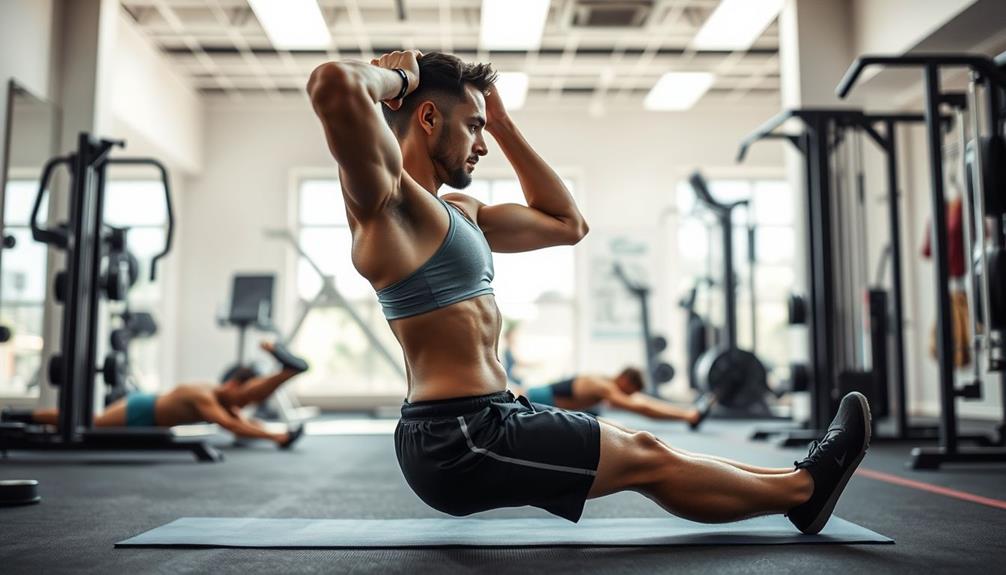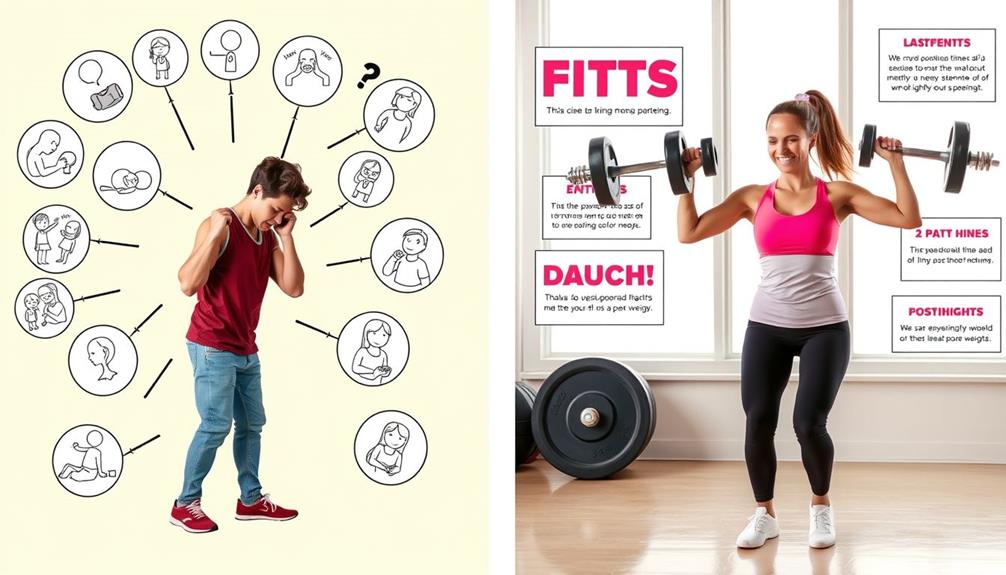Many fitness myths can derail your progress. Cardio alone isn't enough for weight loss; strength training is vital to maintain muscle and boost metabolism. Don't worry, lifting heavy won't bulk you up—it's about toning and improving your body composition. Remember, exercise can't replace healthy eating; nutrition plays a significant role in weight management. Stretching won't prevent all injuries, and scale weight can be misleading. Crunches won't magically create abs; holistic fat loss is essential. Understanding these myths is key to reaching your fitness goals, and there's so much more to explore about effective strategies and practices.
Key Takeaways
- Cardio alone isn't effective for weight loss; strength training is essential for preserving muscle and boosting metabolism.
- Heavy weights do not lead to a bulky physique; they enhance muscle definition and overall body composition.
- Nutrition is crucial for weight management; exercise alone accounts for only 15-30% of daily energy expenditure.
- Dynamic stretching is more effective for injury prevention than static stretching before workouts.
- Scale weight is not a reliable fitness metric; focus on body composition and measurements for a clearer progress picture.
Cardio Is Enough for Weight Loss
Many people believe that cardio is the ultimate solution for weight loss, but that's a misconception. While cardio is effective for burning calories, it isn't enough on its own for ideal results.
If you want to achieve sustainable weight management and transform your body, you need to incorporate strength training into your routine. Strength training not only helps you build muscle mass but also preserves it during weight loss. This preservation is essential for maintaining a healthy metabolism, which is vital for ongoing weight management.
Additionally, focusing on a balanced nutrition plan can further support your weight loss goals, as recommended in various nutrition plans for Kilimanjaro treks.
When focusing solely on cardio, you risk losing muscle along with fat, leading to a slower metabolism. Aim for cardio workouts lasting 20-30 minutes, but don't neglect strength exercises.
By combining both forms of exercise, you'll enhance overall calorie burn, even at rest. To achieve effective and lasting weight loss, you should aim for a caloric deficit through regular exercise and a balanced diet.
Heavy Weights Make You Bulky

You might think lifting heavy weights will make you bulky, but that's a common misconception.
In reality, women typically lack the testosterone needed to gain significant muscle mass like men do. Instead, strength training helps you tone your muscles and improve your overall body composition, leading to a leaner, more defined look.
Additionally, incorporating a balanced lifestyle, including regular physical activity, can further enhance your fitness results and overall health.
Women and Muscle Gain
A common misconception is that lifting heavy weights will make women bulky. In reality, women typically have lower testosterone levels than men, which limits their ability to gain significant muscle mass from weightlifting.
Many women face external influences like societal expectations that may discourage them from strength training; however, embracing weightlifting can lead to numerous psychological benefits, such as improved self-esteem and body image emotional factors.
Instead of becoming bulky, you'll likely experience:
- Increased muscle definition: Your muscles will become more toned and visible without excessive bulk.
- Enhanced fat loss: Strength training promotes fat loss, allowing for a leaner body composition.
- Improved metabolism: Lifting heavy weights boosts your metabolism, helping you burn calories even at rest.
- Stronger bones: Heavy lifting improves bone density, reducing the risk of osteoporosis as you age.
Many women fear the bulky physique seen in competitive bodybuilders, but achieving that level of muscle mass requires strict diets and extensive training regimens.
By incorporating strength training into your routine, you can enhance your overall strength and physical appearance without the unwanted bulk.
Strength Training Benefits Explained
Embracing heavy weights in your strength training regimen can lead to a multitude of benefits, debunking the myth that lifting will make women bulky. In reality, women have lower testosterone levels, which limits their ability to gain significant muscle mass compared to men. Lifting heavy weights won't automatically result in a bulky appearance; instead, you'll likely achieve a toned and defined physique that promotes better body composition.
Moreover, engaging in strength training not only empowers you physically but also encourages a healthy lifestyle, as seen in various healthy lifestyle blogs that emphasize the importance of balanced nutrition and exercise.
One of the main advantages of strength training is that it enhances your metabolism. By increasing your lean muscle mass, you'll burn more calories at rest than fat tissue does. This is essential, especially as metabolism slows with age.
Incorporating heavy weights into your routine not only helps you burn more calories, but it also improves bone density, reducing the risk of osteoporosis as you grow older.
Exercise Can Replace Healthy Eating

Many people mistakenly believe that exercise alone can replace the need for healthy eating, but this isn't the case. While working out is important, it only accounts for 15-30% of your daily energy expenditure.
To effectively manage your weight, a proper nutrition plan is vital. Here's why a healthy diet matters: Regular screenings can reduce breast cancer mortality by approximately 20-30%, emphasizing the importance of a holistic approach to health that includes both exercise and nutrition. mammography guidelines can help inform personal health decisions that go beyond just fitness.
- Caloric Surplus: Poor dietary choices can lead to consuming more calories than you burn, negating any benefits from your workouts.
- Balanced Approach: Research shows that combining exercise with healthy eating habits is essential for sustainable weight loss.
- Caloric Deficit: To lose weight, you need a caloric deficit. Just exercising without adjusting your diet won't help you reach your goals.
- Nutritional Impact: Your nutrition affects overall health and recovery. Exercise alone can't compensate for deficiencies from a poor diet.
Incorporating a balanced diet with your exercise routine is the key to successful weight management.
Don't rely solely on your workout; prioritize your nutrition to see real results.
Stretching Prevents Injuries

You might think stretching is your best defense against injuries, but recent research tells a different story.
While static stretching has its benefits, dynamic stretches like lunges and arm circles are actually more effective for preparing your muscles.
Incorporating dynamic movements can enhance your cognitive development and problem-solving skills, as play-based learning does for children in their growth enhancing cognitive development.
Understanding the right timing and purpose of stretching can help you create a better warm-up routine that truly reduces your risk of injury.
Stretching's True Purpose
While stretching has long been touted as a key component in preventing injuries, research shows it doesn't markedly reduce the risk of harm during physical activity. Instead, it's essential to focus on preparing your muscles effectively. Incorporating elements of music production essentials can enhance your overall approach to fitness.
Here's what you should keep in mind:
- Dynamic stretches like lunges or arm circles are more effective for warming up than traditional static stretches.
- Proper form and technique during your workout are significant for minimizing injuries.
- Stretching post-exercise can aid in recovery and enhance flexibility but isn't a primary method for injury prevention.
- Maintaining a balanced workout routine that includes strength training and mobility work is critical for peak muscle health.
Incorporate these elements into your fitness regimen to better support your body and mitigate injury risks.
Remember, while stretching plays a role in your overall routine, focusing on the right warm-ups and strengthening exercises will contribute more to injury prevention and performance enhancement.
Prioritize dynamic stretches, technique, and a well-rounded workout to keep your body healthy and resilient.
Dynamic Vs. Static Stretching
When preparing for physical activity, choosing the right type of stretching can make all the difference in reducing the risk of injury.
Dynamic stretching, which includes movement-based stretches like lunges and leg swings, is the go-to option for warming up. It effectively activates your muscles and joints, enhancing blood flow and flexibility. Additionally, incorporating elements of cottagecore aesthetics into your environment can create a more serene mindset for your workout. Research shows that incorporating dynamic stretching into your warm-up can improve athletic performance and lower injury risk.
On the other hand, static stretching, which involves holding a stretch in one position, is better reserved for post-workout recovery. Stretching this way before exercising can temporarily reduce muscle strength, leaving you more susceptible to injuries during your workout. Studies indicate that athletes who rely solely on static stretching experience more injuries compared to those who include dynamic stretching in their routines.
To maximize your performance and minimize injury risk, focus on dynamic stretching before your workouts. Ascertain you maintain proper form and controlled movements to prepare your muscles adequately for the demands ahead.
Optimal Timing for Stretching
Understanding the ideal timing for stretching can greatly influence your workout results and injury prevention strategy. Many believe that stretching before exercise is essential, but research shows otherwise. Instead, consider these points:
- Dynamic stretches: Engage in movements that mimic your workout, increasing your heart rate and preparing your muscles without sacrificing muscle strength. Incorporating foods for strong teeth can also support your overall physical health, which is critical for effective workouts.
- Static stretching: Save this for post-exercise, when your muscles are warm. This helps enhance flexibility and aids in muscle recovery.
- Injury prevention: Relying solely on stretching can create a false sense of security; proper form and movement patterns during your workouts are essential.
- Long-term benefits: Incorporating stretching into a regular routine improves overall flexibility and muscle function, leading to better performance and reduced injury risk.
Scale Weight Matters Most

Many people believe that scale weight is the ultimate measure of fitness progress, but this mindset can be misleading. Scale weight fluctuates daily due to hydration levels, food intake, and hormonal changes, making it an unreliable indicator of true body composition changes. You might gain weight from muscle gain while simultaneously experiencing fat loss, since muscle is denser than fat. This highlights the significance of tracking progress through body measurements, rather than fixating solely on weight.
Additionally, understanding safe foods for dogs is essential, as proper nutrition contributes to overall health and fitness, much like how our bodies require a balanced diet for peak performance. Understanding safe foods can play a vital role in maintaining canine health.
Relying solely on the scale can lead to discouragement. You may notice visible changes in your body, but they often won't reflect on the weight scale. Instead, measure your waist, hips, and thighs to gain a clearer picture of your progress. For more accurate readings, weigh yourself consistently at the same time each day, preferably in the morning after using the bathroom.
Understanding that body composition is more important than scale weight can help you set realistic fitness goals. By focusing on overall health and progress, you'll maintain motivation throughout your journey, recognizing that the scale is just one piece of the puzzle.
Calorie Burn Metrics Are Accurate

Relying on the scale for progress can lead to misconceptions about your fitness journey, just as trusting calorie burn metrics from gym machines can be misleading. Many people assume that these machines accurately measure the calories they burn during workouts, but that's often far from the truth.
Here are a few reasons why:
- Inaccuracy: Gym machines can overestimate calorie expenditure by 20-30% due to factors like sex, age, and weight. Additionally, just like understanding safe foods for dogs is vital for canine health, knowing how your body processes calories is essential for your fitness journey.
- Individual Variability: Your body burns calories differently; personal fitness levels and metabolism play huge roles in determining true calorie burn.
- Data Entry Errors: If you enter incorrect data, you might end up with skewed results, failing to account for muscle mass or workout intensity.
- Alternative Tracking: For better accuracy, consider using wearable fitness trackers or calculating your calorie burn using tailored metabolic equations.
Don't fall for exercise myths that suggest machine metrics are gospel truth. Instead, consult a personal trainer to understand how your body burns calories and work towards achieving a calorie deficit effectively.
Crunches Give You Abs

Ever wondered why doing endless crunches hasn't given you the abs you desire? The truth is, crunches primarily strengthen your abdominal muscles but don't strip away the body fat covering them. To achieve those coveted visible abs, men typically need to lower their body fat to about 10-12%, while women should aim for around 11-13%.
Relying solely on crunches isn't the answer. Instead, incorporate cardiovascular exercise and full-core resistance training into your routine for more effective fat loss.
Remember, spot reduction is a fitness myth; you can't target fat loss in one area of your body by doing specific exercises. Fat loss occurs throughout your body, so a well-rounded fitness approach is essential.
Focus on muscle growth through a balanced regimen that includes strength training and a healthy diet. This holistic strategy will help you lose weight and reveal those hidden abs more effectively than crunches alone.
Supplements Are Necessary for Gains

When it comes to building muscle, there's a common misconception that supplements are a must-have for gains. In reality, whole foods often provide the essential nutrients you need more effectively than any supplement. A balanced diet rich in protein, carbohydrates, and healthy fats leads to better muscle growth and recovery.
Consider the following benefits of whole foods:
- Lean meats: Packed with high-quality protein, they support muscle repair.
- Legumes: Great sources of plant-based protein and fiber, promoting overall health.
- Dairy: Offers calcium and protein, essential for strong bones and muscle function.
- Nuts: Provide healthy fats and additional protein, fueling your workouts.
Relying solely on supplements can lead to excessive protein intake, causing potential health issues, like kidney strain.
Your body needs a variety of nutrients for peak performance and recovery, which supplements can't fully replace. Always consult with healthcare providers before starting any supplement regimen, as individual needs vary based on your health status and fitness goals.
Emphasizing whole foods over supplements will help you achieve the best results for your muscle growth.
Sweating Indicates Workout Intensity

Many people mistakenly believe that sweating heavily during a workout is a sign of high intensity and effectiveness. In reality, sweating is just your body's way of regulating temperature, and it doesn't directly correlate with workout intensity or the calories burned. You might burn a lot of calories with a high-intensity workout without breaking a sweat, especially in cooler conditions or if you're well-hydrated.
Here's a quick overview of factors that impact sweating and workout quality:
| Factor | Impact on Sweating | Impact on Workout Quality |
|---|---|---|
| Individual Sweat Rate | Varies by person | Doesn't affect intensity |
| Environmental Conditions | Humidity and heat | Affects comfort, not intensity |
| Hydration Levels | Well-hydrated = less sweat | Quality over quantity |
Focusing solely on how much you sweat can lead to misguided beliefs about your exercise habits. Instead, prioritize workout quality, which involves the intensity and structure of your exercises. Remember, it's not about the sweat you produce, but the effectiveness of your workout that truly matters.
Conclusion
In the quest for fitness, it's easy to cling to myths that seem comforting but can lead you astray. You've learned that cardio alone won't shed pounds, and heavy weights won't necessarily bulk you up. Instead, a balanced approach combining strength, cardio, and nutrition is key. Remember, it's not just about the scale or the sweat; it's about sustainable habits. So, let go of those misconceptions and embrace the truth—your journey to fitness is uniquely yours.









